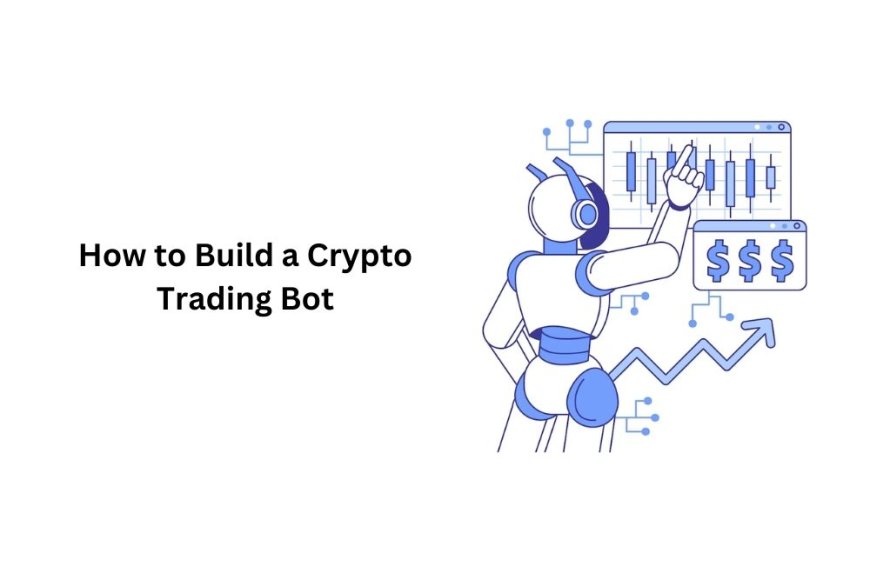How to Build a Crypto Trading Bot from Scratch: A Step-by-Step Guide
Learn how to build a crypto trading bot from scratch with this step-by-step guide. Discover strategies, coding tips, and integration with crypto token development.

Creating a crypto trading bot from scratch can be a rewarding project for developers and crypto enthusiasts. A trading bot is an automated tool that uses predefined strategies to buy and sell cryptocurrencies on your behalf. Whether you're a beginner or an experienced developer, building your own bot can give you valuable insights into the world of automated trading and blockchain technology. This guide will walk you through the process of building a crypto trading bot from scratch, step by step, while integrating some essential aspects of crypto token development. Let’s dive in!
What Is a Crypto Trading Bot?
A crypto trading bot is a software program designed to automate cryptocurrency trades based on predefined algorithms or strategies. These bots monitor market trends, execute buy or sell orders, and optimize trading performance without human intervention. The main benefit of using a bot is that it operates 24/7, allowing for efficient trading in the fast-paced crypto market.
Crypto trading bots can be customized to follow specific strategies, such as scalping, arbitrage, or trend following. By using historical data and real-time market analysis, the bot can perform actions that would otherwise require constant monitoring.
For those involved in crypto token development services, understanding how these bots work is essential. The integration of blockchain-based tokens into trading bots can add another layer of functionality, allowing for more seamless interactions with decentralized finance (DeFi) platforms.
Step 1: Define Your Trading Strategy
Before you begin developing your bot, you need to decide on the trading strategy it will follow. Different strategies work better in different market conditions. Here are a few common strategies used in crypto trading:
- Trend-following: This strategy aims to buy when the price is rising and sell when the price is falling.
- Arbitrage: This involves taking advantage of price differences across different exchanges.
- Scalping: A strategy focused on small, frequent profits through numerous trades.
- Market-making: Providing liquidity on exchanges by setting buy and sell orders near the market price.
Each strategy has its own set of complexities. The bot you build should be capable of implementing your chosen strategy effectively. When working with a crypto token development company, it’s important to understand how these strategies can be integrated into decentralized finance platforms.
Step 2: Choose the Right Programming Language
The next step is choosing a programming language for your bot. Some common languages for developing crypto trading bots include Python, JavaScript, and C++. Python is particularly popular because of its simplicity and powerful libraries, making it ideal for beginners. You can use libraries like:
- ccxt: A cryptocurrency trading library that supports many exchanges.
- Pandas: A library used for data manipulation and analysis.
- TA-Lib: A technical analysis library that helps with implementing common trading indicators.
Once you’ve decided on a language, set up your development environment. Ensure you have a reliable text editor, version control system like Git, and an API key for accessing your chosen exchange.
Step 3: Access Market Data
To make informed trading decisions, your bot will need access to real-time market data. Most crypto exchanges offer public APIs that allow you to fetch live data such as price, volume, and order book information. Popular exchanges like Binance, Kraken, and Coinbase provide these APIs.
Here’s how you can access data using the CCXT library in Python:
import ccxt
exchange = ccxt.binance() # Connect to Binance exchange
markets = exchange.load_markets() # Fetch available markets
ticker = exchange.fetch_ticker('BTC/USDT') # Get price data for Bitcoin
print(ticker)
The data fetched will include the current price, bid, ask, and other relevant information. This data can be used to inform your bot’s trading decisions.
Step 4: Implement Trading Algorithms
Once you have market data, you need to implement your trading algorithms. This is where the real magic happens. A trading algorithm is a set of rules that tells your bot when to buy or sell an asset based on market conditions.
For example, a simple moving average (SMA) strategy could be implemented like this:
import pandas as pd
defmoving_average_strategy(data, short_window=40, long_window=100):
short_sma = data['close'].rolling(window=short_window).mean()
long_sma = data['close'].rolling(window=long_window).mean()
if short_sma[-1] > long_sma[-1]:
return'buy'
elif short_sma[-1] < long_sma[-1]:
return'sell'
return'hold'
In this code, the bot compares short and long-term moving averages to decide whether to buy, sell, or hold. This is just one example of how a simple trading algorithm can be written. You can expand on this by using more complex strategies or integrating machine learning models to predict market trends.
Step 5: Set Up the Trading API
To execute trades, your bot will need access to the exchange’s trading API. Each exchange has its own API documentation, which will guide you on how to place orders, view your balance, and check the status of your trades.
Here’s an example of placing a market order on Binance using the CCXT library:
order = exchange.create_market_buy_order('BTC/USDT', 0.01) # Buy 0.01 BTC
print(order)
When developing with a token development company, you can create a token that integrates with these APIs, enabling automatic trading within decentralized platforms.
Step 6: Backtest Your Strategy
Backtesting is a critical step in developing a crypto trading bot. It involves running your trading strategy on historical data to see how it would have performed in the past. This is important because it allows you to understand the effectiveness of your strategy and make any necessary improvements.
To backtest your strategy, you can use historical price data (many exchanges provide this through their APIs) and run it through your algorithm. This will give you insights into how your bot would have reacted to market conditions and help you optimize its performance.
Step 7: Implement Risk Management
Risk management is crucial when developing any trading bot. Without it, your bot could make massive losses in a volatile market. Some common risk management techniques include:
- Stop-loss: Automatically selling an asset when its price drops by a certain percentage.
- Take-profit: Automatically selling when a certain profit target is reached.
- Position sizing: Limiting the amount of capital your bot risks on each trade.
By implementing risk management, you can protect your capital and ensure that your bot only takes calculated risks. This is an essential part of building a sustainable crypto trading bot.
Step 8: Run the Bot and Monitor Performance
Once your bot is set up, it’s time to run it live. However, running a crypto trading bot requires continuous monitoring to ensure it’s functioning correctly. Market conditions can change rapidly, and bots should be adjusted accordingly.
Ensure that your bot has error-handling mechanisms in place to deal with unexpected issues like API outages or connectivity problems. Regularly monitor your bot’s performance and make adjustments as needed.
Step 9: Optimize and Improve
Building a crypto trading bot is not a one-time project. As market conditions evolve, so should your bot. Regularly review your bot’s performance and optimize the algorithms for better accuracy. You can also integrate machine learning models to improve predictions or add more advanced features like sentiment analysis or news-based trading.
Many crypto token development services help integrate trading bots with various decentralized exchanges and token ecosystems. By working with a professional company, you can integrate your trading bot with DeFi protocols for increased functionality.
Conclusion
Building a crypto trading bot from scratch can be an exciting and rewarding project. It requires a solid understanding of programming, market analysis, and trading strategies. By following these steps, you can create a bot that trades effectively and optimizes your crypto portfolio.
If you’re interested in token development or need crypto token development services for your project, partnering with a professional company can help you integrate your bot into decentralized finance platforms. By automating your trading and making data-driven decisions, you can stay ahead in the fast-paced crypto world.
What's Your Reaction?























